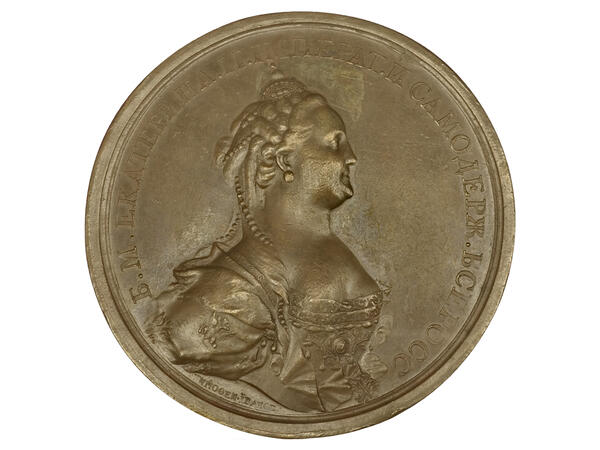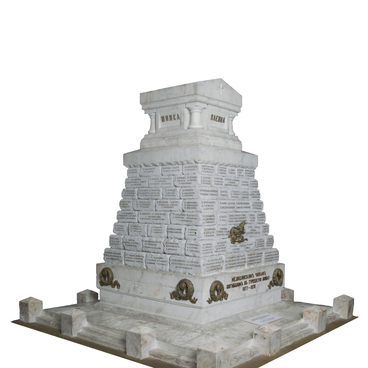The collection of the Military Medical Museum contains a commemorative medal on the introduction of smallpox vaccination to Russia. It was made by the medalist of the St. Petersburg Mint Timofey Ivanov. The master placed a profile portrait of Empress Catherine II on the obverse — a front face of the medal. And on the reverse of the medal, he embossed a plot scene: Catherine and her son Paul, the future emperor, leave the temple of Aesculapius, healed of smallpox. They are greeted by a woman, bowing respectfully — this is how the artist allegorically depicted the Russian Empire. At the gate of the temple lies a defeated hydra, which symbolizes the defeated smallpox.
Mass vaccination against smallpox in Russia was one of the main initiatives of Empress Catherine II. The reason for the vaccination was the raging epidemic of black, or natural, smallpox in St. Petersburg in the summer of 1768.
This extremely contagious and deadly disease filled Catherine with serious apprehensions.
Medal. Start of smallpox vaccination in Russia
Creation period
1768
Technique
copper, casting
Collection
Exhibition
3
Open in app#4
Timofey Ivanov
Medal. Start of smallpox vaccination in Russia
#2
#5
I never had smallpox, she wrote to the Moscow commander-in-chief Pyotr Saltykov, and was compelled to be constantly apprehensive both about myself and about the grand prince, even with all the precautions taken, and especially this summer, as this disease has greatly increased in St. Petersburg […]. This impelled me to overcome these fears and to save myself and the whole state from unsafe uncertainty by inoculating myself with smallpox.
Empress Catherine II
#6
In July 1768, an English doctor Thomas Dimsdale was invited to St. Petersburg to vaccinate the empress and her son Paul. At that time, variolation was the main method of controlling smallpox. When a pustule matured on the body of a person with a mild form of natural smallpox, detritus — gruel from decayed tissues — was taken from it. Then, an incision was made on the skin of a healthy person, through which a thread soaked in smallpox detritus was pulled. Variolation was a risky procedure — the vaccinated person had a chance of contracting a severe form of natural smallpox and dying.
On October 12, 1768, Thomas Dimsdale brought a 7-year-old Sasha Markov to the Winter Palace from the hospital; the first symptoms of the disease began to show on the boy’s body. The doctor took detritus from the boy and inoculated Catherine II with it. The Empress left for Tsarskoye Selo to be treated for a mild form of smallpox. Soon, the heir to the throne, grand prince Pavel Petrovich was vaccinated as well. They both developed immunity to the disease.
After the recovery of Catherine II, her subjects became much more willing to come to the “smallpox houses” for vaccination. Thomas Dimsdale was favored the title of Baron and the title of physician in ordinary, and a large pension. The Empress granted Sasha Markov a noble title with a family coat of arms and a new surname — Markov-Ospenny [Ospenny means Smallpox — ed.]. The coat of arms of Ospenny noble family showed a bare arm with a big pockmark above the elbow holding a pink flower with a green stem and leaves set against the golden field.
On October 12, 1768, Thomas Dimsdale brought a 7-year-old Sasha Markov to the Winter Palace from the hospital; the first symptoms of the disease began to show on the boy’s body. The doctor took detritus from the boy and inoculated Catherine II with it. The Empress left for Tsarskoye Selo to be treated for a mild form of smallpox. Soon, the heir to the throne, grand prince Pavel Petrovich was vaccinated as well. They both developed immunity to the disease.
After the recovery of Catherine II, her subjects became much more willing to come to the “smallpox houses” for vaccination. Thomas Dimsdale was favored the title of Baron and the title of physician in ordinary, and a large pension. The Empress granted Sasha Markov a noble title with a family coat of arms and a new surname — Markov-Ospenny [Ospenny means Smallpox — ed.]. The coat of arms of Ospenny noble family showed a bare arm with a big pockmark above the elbow holding a pink flower with a green stem and leaves set against the golden field.
#3
Ministry of Culture of the Russian Federation
read morehide
00:00
00:00
1x
Medal. Start of smallpox vaccination in Russia
Creation period
1768
Technique
copper, casting
Collection
Exhibition
3
Open in app
Share



